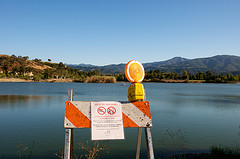 Groundwater flow direction, either measured or predicted, is a piece of data that’s provided in just about every Phase I report you’ll read — and certainly in any Phase II report. In Phase I, groundwater flow is estimated based on topographic maps and the lay of the land. Most Phase II reports include a measured groundwater flow survey, relying on monitoring wells to calculate the underground water surface topography…and thus the flow direction. It’s not an exact science, and discrepancies can result in consultants pointing their fingers at one another. It can also lead to unexpected cleanup costs, long after remedial estimates have been published and escrows negotiated.
Groundwater flow direction, either measured or predicted, is a piece of data that’s provided in just about every Phase I report you’ll read — and certainly in any Phase II report. In Phase I, groundwater flow is estimated based on topographic maps and the lay of the land. Most Phase II reports include a measured groundwater flow survey, relying on monitoring wells to calculate the underground water surface topography…and thus the flow direction. It’s not an exact science, and discrepancies can result in consultants pointing their fingers at one another. It can also lead to unexpected cleanup costs, long after remedial estimates have been published and escrows negotiated.
Illustrating this point is the case of the Burgess Brothers Landfill site in Bennington, Vermont. While a former landfill and superfund site is not what a lender would consider a prime piece of collateral, it does emphasize one point in particular: Even a contaminated site that has been accounted for, in terms of remediation costs, can turn out to be much more of a financial burden than originally anticipated…and changes in groundwater flow direction can often be the culprit. Groundwater flow changes are caused by many factors, not the least of which is development — both in regards to changes in land use on the surface and greater strain of the groundwater supply, which tends to lower the groundwater table.
So what to do as a lender in a similar circumstance? When a substantial remedial effort has already been undertaken and it’s obvious that contamination is still present, consider one of many environmental insurance products, such as “cap coverage”, which will cover overruns in scope and related cost. Requiring a beefed-up escrow to cover the life of the loan would be an alternative to insurance.
